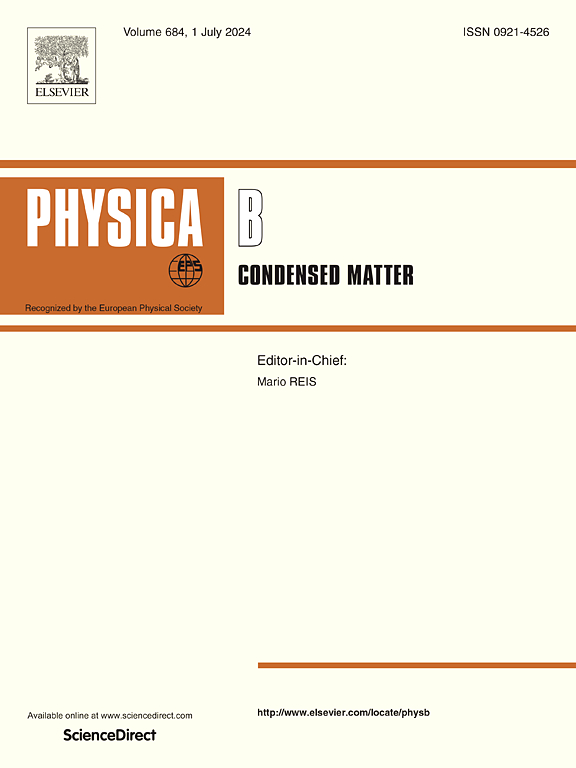Unveiling the synergistic impact of asymmetric oxygen doping and biaxial strain on the photoelectric properties of GaSe/MoS2 heterojunctions: A first-principles study
IF 2.8
3区 物理与天体物理
Q2 PHYSICS, CONDENSED MATTER
引用次数: 0
Abstract
A systematic investigation was conducted into the electronic structure and optical property regulation mechanisms of GaSe/MoS2 heterojunctions. The investigation was based on first-principles calculations. The built-in electric field induced by interfacial electron migration was significantly enhanced under combined O doping and strain regulation. This enhancement has been demonstrated to result in improved charge separation efficiency. Applying biaxial tensile strain to the doped system has resulted in a transition from an indirect bandgap to a direct bandgap. The bandgap value has gradually decreased from 0.98 eV (eV) at 2 % strain to 0.59 eV at 8 % strain.Conversely, compressive strain initially reduces the bandgap value of the doped system and subsequently causes it to increase gradually, reaching a maximum of 1.55 eV. Furthermore, optical analysis demonstrates that O doping exerts a suppressive effect on enhancing optical peak intensity through precisely calibrating electronic states. Strain instigates red shifts in absorption and reflection peaks, modulating the energy level distribution and expanding the photoresponse range. This study unveils a practical approach to regulating the optical properties of two-dimensional heterojunctions through the synergistic effects of doping and strain, thus providing significant references for designing efficient optoelectronic devices. Furthermore, it provides a theoretical basis for applying GaSe/MoS2 heterojunctions in optoelectronic devices.
揭示不对称氧掺杂和双轴应变对GaSe/MoS2异质结光电性能的协同影响:第一性原理研究
系统地研究了GaSe/MoS2异质结的电子结构和光学性质调控机制。这项调查是基于第一性原理的计算。在O掺杂和应变调节的联合作用下,界面电子迁移引起的内嵌电场明显增强。这种增强已被证明可以提高电荷分离效率。对掺杂体系施加双轴拉伸应变导致了从间接带隙到直接带隙的转变。带隙值从2%应变时的0.98 eV (eV)逐渐减小到8%应变时的0.59 eV。相反,压缩应变首先降低掺杂体系的带隙值,随后使其逐渐增大,最大可达1.55 eV。此外,光学分析表明,O掺杂通过精确校准电子态对增强光峰强度有抑制作用。应变引起吸收和反射峰的红移,调制能级分布,扩大光响应范围。本研究揭示了一种通过掺杂和应变的协同效应调控二维异质结光学特性的实用方法,为设计高效光电器件提供了重要参考。为GaSe/MoS2异质结在光电器件中的应用提供了理论基础。
本文章由计算机程序翻译,如有差异,请以英文原文为准。
求助全文
约1分钟内获得全文
求助全文
来源期刊

Physica B-condensed Matter
物理-物理:凝聚态物理
CiteScore
4.90
自引率
7.10%
发文量
703
审稿时长
44 days
期刊介绍:
Physica B: Condensed Matter comprises all condensed matter and material physics that involve theoretical, computational and experimental work.
Papers should contain further developments and a proper discussion on the physics of experimental or theoretical results in one of the following areas:
-Magnetism
-Materials physics
-Nanostructures and nanomaterials
-Optics and optical materials
-Quantum materials
-Semiconductors
-Strongly correlated systems
-Superconductivity
-Surfaces and interfaces
 求助内容:
求助内容: 应助结果提醒方式:
应助结果提醒方式:


